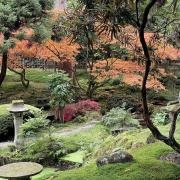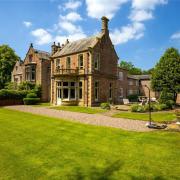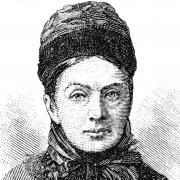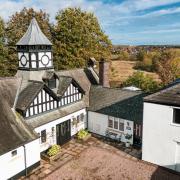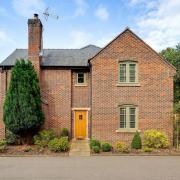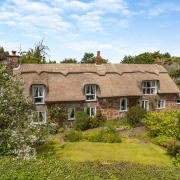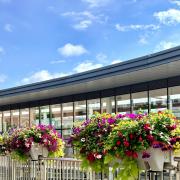In 1995, David Mottershead (yes, of those Mottersheads, who founded Chester Zoo in the 1920s) took redundancy from Johnston’s Paints, bought a tiny factory in the foothills of Snowdonia and established a protective coatings company, Bradite.
Over the next five years David began to dream of setting up a company that would offer sustainable, eco-friendly, luxury paints that also tapped into our magnificent heritage and history. At the same time, he was being approached by design-led brands seeking to develop their own paint ranges – unsurprisingly, there aren’t a lot of paint factories in the UK, and even fewer able to offer the kind of bespoke service David and his team could.
“Companies like Fired Earth, William Morris, Sanderson, Ralph Lauren, were coming to ask us to manufacture for them,” Ruth Mottershead, David’s daughter and Little Greene’s creative director, says. “By 2001 he felt like he was in the right position to set up his own paint brand, making the best quality paint it’s possible to make.”

That brand was Little Greene. The name is a lovely nod to the colour heritage of the address in Manchester where David set up his offices. In 1773 the site was occupied by The Little Greene Dye Works, where during the industrial revolution exotic woods, imported from across the globe, were processed to create dyes, which were then used to dye the cotton that was at the heart of Manchester’s growth during this period.
David was joined by son Ben and daughter Ruth in 2011.
“Dad mentioned he was considering stepping back from the business and contemplating how this might look in terms of the future, and Ben and I, despite having both forged our own careers – Ben in the Metropolitan Police and myself as a landscape architect – both said we’d like to become a part of it all.
“Ben has a very scientific background. He trained as a veterinarian, before deciding to join the police, and my background is very creative, so we have both quickly found our niches, Ben in operations and myself in marketing.”
There’s no standing still in interior design, colour trends come and go and the colour palette offered to clients must therefore also move and change over time, but how does this work?

“I’m the ‘chief colour curator’, you might say,” Ruth explains. “We split our colours into two areas – the neutrals, and the colours, the greens and blues, reds and yellows. When we’re looking at developing new colours or retiring others, we look at changes in what people are starting to buy, and trends in interior décor.
“For example, the neutrals have been popular for ten years, now, the greys for example we launched in 2013, but we’re now seeing a step towards stonier tones. I can see the shift in the market from the cooler greys, with a blue undertone, to people buying warmer greys with a red undertone. I felt that from there we would see a move into earthier, richer colours – people wanting to bring more natural tones inside their homes, wanting to create more comfortable spaces. So we worked on developing new neutrals, in stone colours – not beige, not magnolia, but colours positioned slightly away from grey with warmer undertones, in yellow, red, pink or green – the Portland Stones, the Rolling Fogs, the Clays, really lovely natural colours.
“The other side of things is the ‘trend’ colours, these are colours that might be popular for a few years and then we’re on to the next colour. For example in the last year or two there’s been a lot of terracotta; our popular colours like Heat, Tuscan Red, Middle Buff, colours that have that lovely orangey-peachy undertone, and this movement will fed into my thinking about the next colour palette to bring together.”
This brings us to Sweet Treats, the latest collection from Little Green, a capsule collection of nine warm shades of honey, caramel and chocolate, designed to support an increasing need to create cosy, enveloping interiors and restful spaces.

“I believe chocolately colours, caramels and honey tones are going to be a key trend for the next couple of years. I started by putting together a mood board, colours I’d seen in fabrics, in fashion designs, an archive paint colour. Then I have to specify how many colours and how to make it an easy to use collection – so the card has nine colours for example, in three columns – one honey, one caramel and one chocolate. I then meet with our colour specialist Simon and the team in the lab, and explain what I want. Chocolate Colour (a rich, deep dark chocolate shade) is one of our existing collection, and then we needed to create colours that met my other wants. I also go and have a look in our National Trust archive, and there were quite a lot of colours there that met the brief, Split Pink and Mochi, for example.
“Simon made suggestions, our sales director had ideas, David had his own thoughts, and so it’s a very collaborative process until we achieve the final colour palette to take to the market.”

Sweet Treats launched just this month, and the glorious photography produced shows just how each shade will bring that sense of comfort and calm we all get when indulging in our favourite goodies – and not a calorie in sight.
Little Greene have created a number of period paint colour collections, working with the National Trust to discover paints used across the centuries and recreate these for use today. As you’d expect, there are the muted shades of the Georgian era, vibrant Regency tones (think Bridgerton) and darker Victorian shades, but there are also collections of paint colours first used in the 1930s, 1950, 60s and 70s, making it easy for homeowners who want to engage with the age of their home (or who simply love the fashions of a particular era) to find colours actually used ‘back in the day.’
“The 20th century paint collections were a project we undertook with Crick-Smith, the historic paint researchers and analysts, working across different sites and delving into their archive. For example, Hicks’ Blue was used by designer David Hicks at the top of the British Telecom Tower, in 1962. All the colours we have chosen have a story behind them.
“All our heritage colours sit in the colour cards, not as separate collections, except on the website, so you might look specifically for a colour from a particular era, or simply find a colour you love and then discover it’s a Regency colour, or from the 1970s.”

Little Greene introduced their wallpaper collections 15 years ago, a glorious selection inspired by designs used in English homes over centuries.
“It just made sense to introduce wallcoverings,” Ruth says. “It made us more of a design brand than a design brand, I think. They go hand in hand and it makes sense to make papers in Little Greene colours so people choosing a paint can choose a complementary paper, or the other way round. We started with English Heritage and then more recently have collaborated with the National Trust. The designs are taken from ceramics, paintings, wall coverings and painting. The archives cover about 300 years of decoration. The earliest one we have is from 1760, New Bond Street, and is actually a piece of leather that would have been a wall hanging. It wasn’t until the 1830s that wallpaper really became accessible, with the development of machinery to allow it to be made in rolls, which obviously brought the cost within reach of the middle classes, not just the very wealthy.”

Paint, historically, hasn’t been closely associated with the term ‘environmentally friendly’, though Little Greene has worked hard to ensure their own paints are as sustainably made and eco-friendly as possible. Their water-based paints carry almost zero VOCs, and their oil-based paints are made using sustainable vegetable oils. And just this year the company has gone one huge step further, and developed a way to recycle their own paints, retailing the new shades at 50 per cent of the cost of their new made paints.
“Re:mix is made using recycled paint. Sometimes we get paint that’s refused at the door (a customer has changed their mind, for example, or the tin is damaged, or there’s a spill with a pallet of paint, for example. On average we get about 60,000 litres of paint back each year. It’s a bit of an elephant in the room issue across the whole paint industry, because there’s a lot of waste paint and the only way to get rid of it is to incinerate it or send it to landfill. So instead of this, we decided we’d make a recycled product. It’s made of a mix of our bestsellers – Intelligent Matt, Absolute Matt and Intelligent Eggshell – all water-based products. We can make it in 20 different colours. We put the returned paint into colour batches – all the whites, all the pinks, the greens, the blues, etc, and then add tint to it to bring it to be the colour we want it to be. So Livid, for example, is one of our bestselling paints, and we make this also in Re:mix. It might be made up of some Livid that got sent back, some Pleat that got sent back, some Tracery, some white and then we add a slight tint to make sure it’s Livid. It won’t be an exact match, of course, but it’s the nearest match we can get using the recycling process. It’s a complex and laborious process, but we felt as a company that it was important to do it.”

Little Greene have just opened their first store in the North, in Wilmslow, although there are already five in London, and in Munich and Paris. Already popular with interior designers and consumers in the UK and Europe, a growing demand from the United States has led to the brand opening their first showroom on the other side of the Atlantic last month.
“For years and years we kept getting asked, when are you going to be selling in the USA?” Ruth says. "American designers would want to know how to get hold of our paints. They really like British products and our focus on the quality of manufacture. There’s no real luxury paint
There’s no real luxury paint market there, yet, and I think what they like is that we have more limited, curated colour palettes to choose from and, of course, the heritage collaborations we offer through the National Trust.
“Our showroom will be in Greenwich, Connecticut, which is rather like the Wilmslow of New York, and then of course people will be able to buy our paints in certain décor stores around the country, or online.”
It seems we can expect to see Little Greene popping up on walls from Wilmslow to Washington, and all from a small factory in the foothills of Mount Snowdon.







